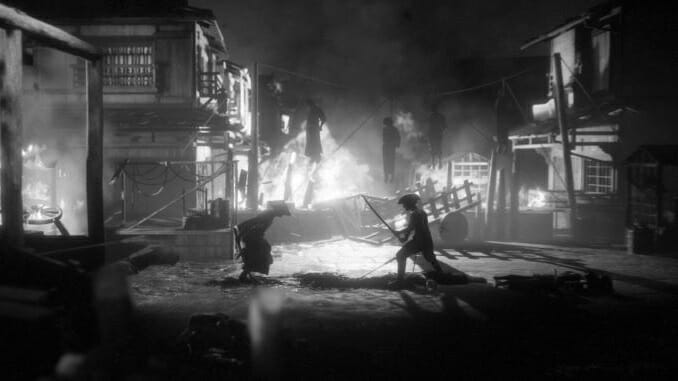Trek to Yomi Is Another Stab at a Kurosawa-Aping Samurai Game

Trek to Yomi is a side-scroller parry-based samurai fighting game set in Japan’s Edo period, shot in black-and-white with artificial screen aging effects added to evoke Akira Kurosawa’s samurai films of the 1950s and 1960s. It’s a relatively straightforward action game that nonetheless provides exploration opportunities and multiple, eventually convergent, paths through its world. The art style is functional and effective through the first three chapters, but after the protagonist Hiroki (Masayuki Kato) is felled by an unbeatable boss, players get to explore Yomi, an afterlife realm of the Shinto religion, and that’s where it really shines. Of course, as another in a long line of games made by non-Asians focused on depicting Asia, it raises questions about appropriate ways to depict other people’s cultures. Moreover, it’s held back by the need to remind players of what’s come before rather than being something new.
Trek to Yomi builds on the ongoing fascination with bringing the highlights of cinema to interactive entertainment, playing with black-and-white coloring, lighting, and angles to evoke Akira Kurosawa’s iconic filmography. Players that find this adoption distracting can turn the bloom filter and grain filter off for a clearer picture, but there’s no accessibility setting beyond subtitles, though there are over a dozen languages to select from for text. The audio is all in Japanese.
Players take hold of Hiroki as a child, training with his sensei, Sanjuro (Hiroshi Shirokuma), in a combat tutorial that gives way to a prologue where Hiroki first bloodys his sword in defense of his village. Players quickly meet Sanjuro’s daughter and Hiroki’s best friend and love interest Aiko (Sarah Emi Bridcutt), as well as the village-storming bandit villains Sadatame (Hiroki Goto) and Kagerou (Akio Otsuka). The game quickly advances Hiroki and Aiko to adulthood as the village’s new leaders, who find themselves under attack by familiar bandits.
Trek to Yomi is very digestible on the medium setting—it took 10 hours to complete with me seeking out a lot of the collectible artifacts and stamina/health augments, and often I found bosses or groups of enemies turn from frustratingly difficult to surprisingly easy after a few tries, a familiar experience for any gaming enthusiast. The fact that there are other path choices imply that there are other directions to take, but achievements based on acquiring unlockables make it seem like there’s ultimately just one way to go. At least once it’s implied that players can end the game early, like in Katana Zero, if they forgo vengeance or duty in one of the game’s three instances of offering a dialog choice in Hiroki’s path. That would mean players have the choice not to see all of the game’s underworld, which would be a poor decision: it’s an underworld worth seeing.
The moment-to-moment gameplay, while enjoyable, isn’t especially complex. Players have two verbs to utilize throughout most of the game, run and fight, and can’t use the former to avoid the latter. It’s primarily a melee game and, while I found the fighting somewhat frustratingly unresponsive at the beginning, unlocking combos throughout the game creates beautifully choreographed and articulated swordplay that feels truly cinematic. While it’s not super fun to get boxed into an edge of the screen by enemies, pulling off consecutive parries around enemies to slash them down offers a palpable thrill, while also looking cool as hell. Unfortunately, the roll movement feels rather ineffective, as it seldom allows Hiroki to move past opposing fighters, and if poorly timed going backwards will be broken by an opponent attack. Players also receive shuriken, a longbow, and an ozutsu flintlock cannon. There’s an exciting variety of opponents throughout the upper and lower world, as well, with different styles of bandits, “blighted” and “tainted” undead, as well as wraiths, spirits, and demons.
While the first game I compared Trek to Yomi to in my mind was Katana Zero, the combat reminds me much more of a simplified Soulsborne. It relies heavily on parries, counters, and timing your shots. The fixed camera that changes direction between areas resembles the original God of War games on the PlayStation 2, though the variation of angles here reminds me of cinema, as it was intended to evoke. The furthest depths of Yomi, when the game really engages with the mystic and mythical, feels like Arkham Asylum’s Scarecrow sequences and the indie adventure game Genesis Noir, especially as it introduced puzzles that, while simple, at least provide a third method of interacting with the world. I also found myself thinking of Ninja Gaiden, where—like in this story and many others before and since—the protagonist returns to his village to see it is under attack and begins a quest for vengeance.
It’s a frequently beautiful game throughout, but especially in the afterlife. It’s more distinct and surreal than the parts of the game seeking to remind you of Yojimbo and Seven Samurai. What comes next feels appropriately unreal.
-

-

-

-

-

-

-

-

-

-

-

-

-

-

-

-

-

-

-

-

-

-

-

-

-

-

-

-

-

-

-

-

-

-

-

-

-

-

-

-








































